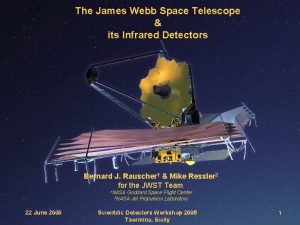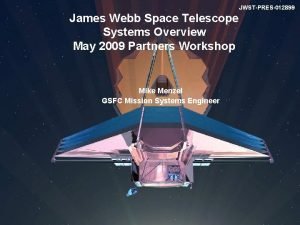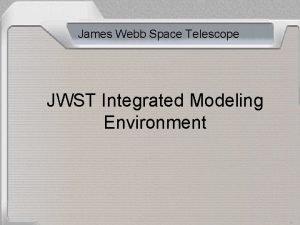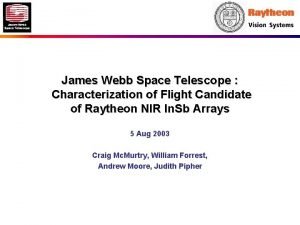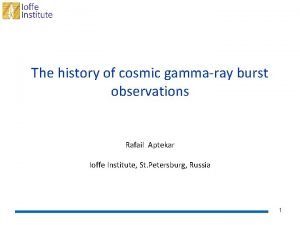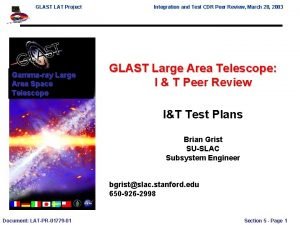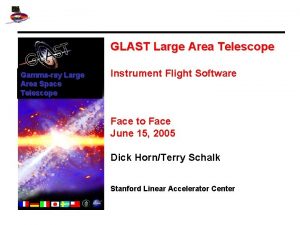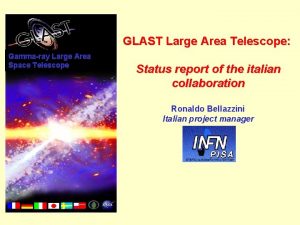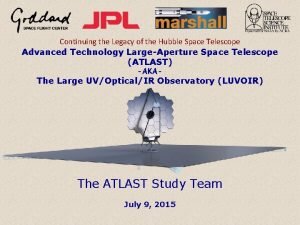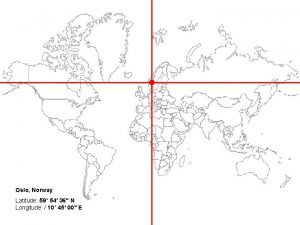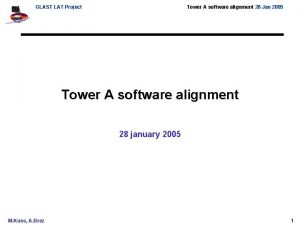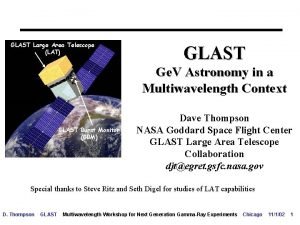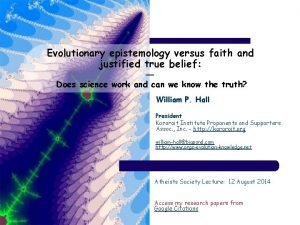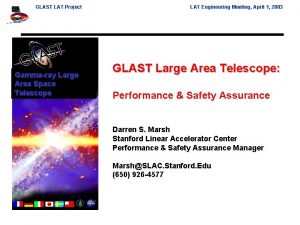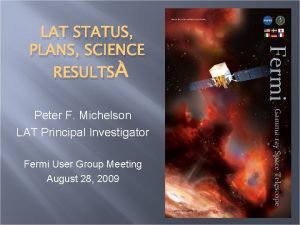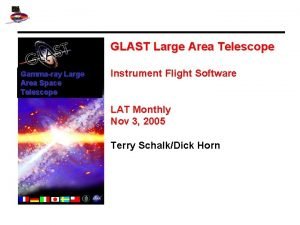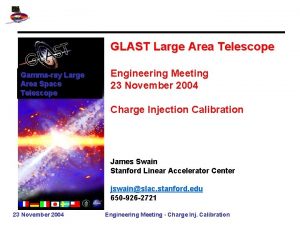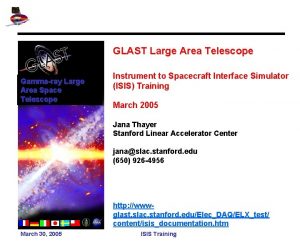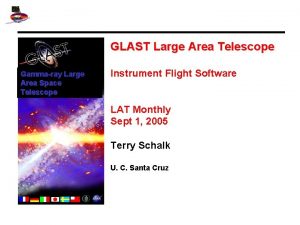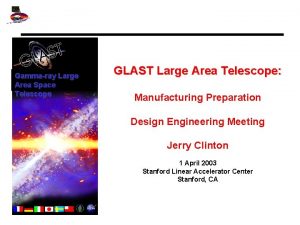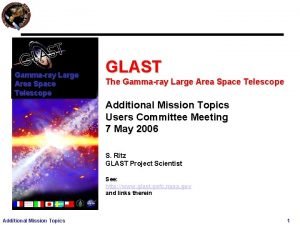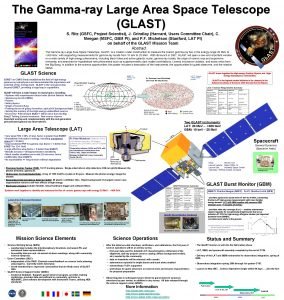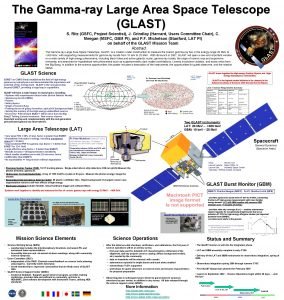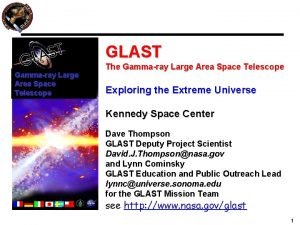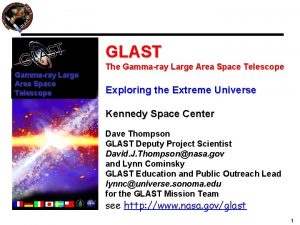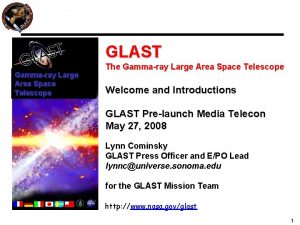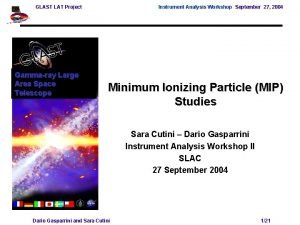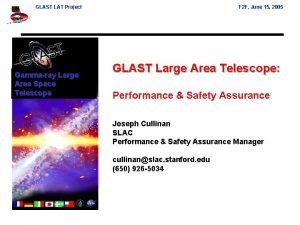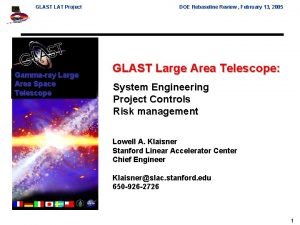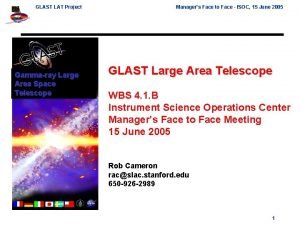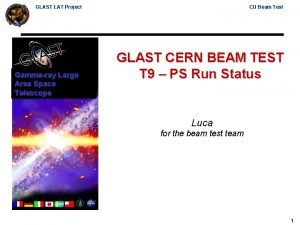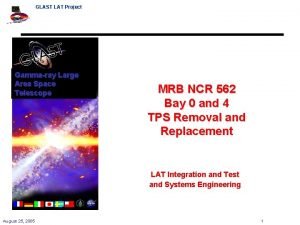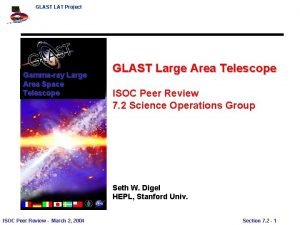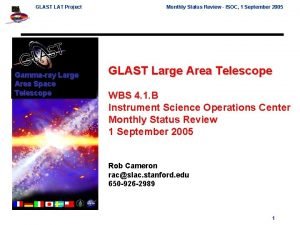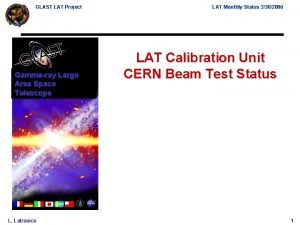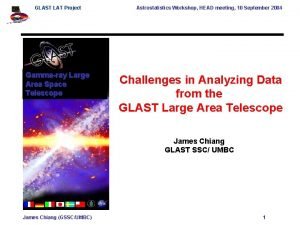GLAST LAT Gammaray Large Area Space Telescope Solar










































- Slides: 42

GLAST LAT Gamma-ray Large Area Space Telescope Solar System WG GLAST Large Area Telescope Solar System Working Group Activities and Prospects Francesco Longo On behalf of the Solar System WG Thanks to Gerry Share, Ron Murphy, Chuck Dermer, Jim Chiang, Seth Digel, Igor Moskalenko, Troy Porter, Andy Strong, Elena Orlando, Dirk Petry, Riccardo Rando, Giulia Iafrate, Gottfried Kanbach, Nicola Giglietto and Monica Brigida Credits to NASA for most pictures ESRIN July 3, 2007 F. Longo

GLAST LAT Solar System WG • Purpose: Analyze Sources in the Solar System – Sun(quite and flaring), Moon, Earth, … • Small Group: ~ 25 people • Coordinators: Gerry Share and Francesco Longo • Typical analysis threads: – Moving Sources – Flaring Sun and Instrument deadtime – “Multimessenger analysis” ESRIN July 3, 2007 F. Longo

GLAST LAT Solar System WG Group Activities • • • Solar flare modeling & detection – RHESSI data analysis of flares – Pion Decay, Neutron spectra and light curve calculation – Preliminary estimates of LAT detection of solar n LAT behaviour during a Solar flare – LAT induced dead time Inputs from Diffuse Group – Solar IC emission from CR e– EGRET data analysis on Sun Emission – Moon spectrum Data analysis – SC simulation (RHESSI light curve and EGRET spectra) – DC 2 analysis of moon transit – Moving Sources The Earth – Extension of Petry results on gamma ray albedo – Terrestrial Gamma Flashes (GBM) ESRIN July 3, 2007 F. Longo

GLAST LAT Solar System WG Introduction to Flaring Sun ESRIN July 3, 2007 F. Longo

GLAST LAT Solar System WG GLAST Solar capabilities • Solar activity expected to rise in ~2008 and peak as early as 2011 • GLAST is the only satellite capable of making solar observations >30 Me. V • Coordinated LAT gamma-ray measurements with GBM (10 ke. V 25 Me. V) and RHESSI (1 ke. V – 20 Me. V; anneal in the next half year) • Comparison with solar energetic particle measurements on ACE, STEREO, SOHO, WIND and ground based neutron monitors, muon telescopes, Milagro • Ten’s of high-energy flares will be observed • ~20% solar coverage (~60% with To. O) • Links to NASA Living with a Star and Sentinels programs ESRIN July 3, 2007 F. Longo

GLAST LAT Solar System WG Flare Model ESRIN July 3, 2007 F. Longo

GLAST LAT Solar System WG Gamma-Ray Line Spectra Measured by SMM Pion Contribution ESRIN July 3, 2007 F. Longo

GLAST LAT Solar System WG What should GLAST see? • image the sites of acceleration to less than 5’, and reveal whether image the sites of acceleration they are point-like or extended (for energies extending to 10 Ge. V) point-like or extended • LAT sensitivity and dynamic range offer significant improvements for studying flare spectra and their time evolution • greater immunity from saturation, with a deadtime three orders greater immunity from saturation of magnitude less than EGRET: study the initial, impulsive phase • wider field of view monitoring of solar flares (with GBM) and study of the flare evolution simultaneously across the entire ke. V-Ge. V energy range • launched near the solar minimum: frequency and intensity of solar flares will increase throughout most of the planned mission • if the goal of a 10 years mission life is achieved, GLAST will operate for nearly the entire duration of solar cycle 24 ESRIN July 3, 2007 F. Longo

GLAST LAT Solar System WG RHESSI and GLAST ESRIN July 3, 2007 F. Longo

GLAST LAT Solar System WG RHESSI data Analysis and GLAST • Be prepared to analyze RHESSI and GLAST data – RHESSI: Reuven Ramaty High Energy Solar Spectroscopic Imager MISSION OBJECTIVE: EXPLORE THE PHYSICS OF PARTICLE ACCELERATION AND ENERGY RELEASE IN SOLAR FLARES ESRIN July 3, 2007 F. Longo

GLAST LAT Solar System WG 20 January 2005 06: 44 -06: 56 TRACE 1600 A at 06: 52: 30 UT 250 – 500 ke. V 30, 50, 70, 90% contours 2215 -2231 ke. V centroid 1 - error circle RHESSI, (Hurford et al. 2007) GLAST Location Localize the source of >1 Ge. V photons to ~30 arc sec ESRIN July 3, 2007 F. Longo

GLAST LAT Solar System WG Spectral Evolution ESRIN July 3, 2007 F. Longo

GLAST LAT Solar System WG Long duration -ray flares ∙ -ray (and/or neutron) emission (> 1 Me. V) present well beyond the impulsive phase: – particles accelerated in the impulsive phase and trapped at the Sun and/or – particles continuously accelerated • E. g. June 11 1991 flare: – Time-extended emission of 2. 223 Me. V radiation – Lasting over 5 hours (Comptel on CGRO) • Long-lasting (> 8 hours) high-energy component -ray emission > 50 Me. V (EGRET spark chamber) G. Kanbach et al. (1993) E. J. Schneid et al. (1996) P. P. Dunphy et al. (1999) ESRIN July 3, 2007 F. Longo

GLAST LAT Solar System WG 11 June 1991 Flare ESRIN July 3, 2007 F. Longo

GLAST LAT Solar System WG Modeling of solar flare emission ESRIN July 3, 2007 F. Longo

GLAST LAT Solar System WG Solar Flare Model ESRIN July 3, 2007 F. Longo

GLAST LAT Solar System WG Nuclear Emission Processes Murphy et al. 2007 ESRIN July 3, 2007 F. Longo

GLAST LAT Solar System WG Ion spectra and Lines Murphy et al. 2007 ESRIN July 3, 2007 F. Longo

GLAST LAT Solar System WG Neutron Spectra Murphy et al. 2007 ESRIN July 3, 2007 F. Longo

GLAST LAT Solar System WG LAT and Neutrons Tracker Interaction ESRIN July 3, 2007 Calorimeter Interaction F. Longo

GLAST LAT Solar System WG Effects of Solar Flares on the LAT ESRIN July 3, 2007 F. Longo

GLAST LAT Solar System WG Saturation Effects • Saturation effects in the upper Si layers due to intense 20 -150 ke. V X-rays. For a flare with peak hard X-ray intensity ~10% of the largest expected: – ~1. 2 106 photons s-1; – 0. 1 mm of W reduces flux to ~2. 2 105 photons s-1; – taking into account energy deposition in Si (>30 ke. V) – 5 103 counts s-1 in top layer of silicon ~ 1% deadtime • At the peak of the most intense flare expect ~ 10% deadtime in top Si layer • ACD tile + threshold > 0. 3 Me. V OK ESRIN July 3, 2007 F. Longo

GLAST LAT Solar System WG The Quiet Sun ESRIN July 3, 2007 F. Longo

GLAST LAT Solar System WG Inverse Compton scattering e ©UCAR The heliosphere is filled with Galactic cosmic ray electrons and solar photons electrons are isotropic photons have a radial angular distribution ESRIN July 3, 2007 F. Longo

GLAST LAT Solar System WG The ecliptic Galactic plane Averaged over one year, the ecliptic will be seen as a bright stripe on the sky, but the emission comes from all directions >100 Me. V Current EGRB >1 Ge. V AC ecliptic 70° GC IS spectrum Modulated 500 MV Modulated 1000 MV ESRIN July 3, 2007 F. Longo

GLAST LAT Solar System WG Spectrum =0. 25° 1° 5° 45° =0, 500, 1000 MV 10° IC spectrum <1 Ge. V shows strong dependence on the modulation level Variations of -ray flux over the solar cycle 180° IC integral flux F(>100 Me. V, <2. 5°)~2 x 10 -7 cm-2 s-1 EGRET upper limit =2 x 10 -7 cm-2 s-1 ESRIN July 3, 2007 F. Longo

GLAST LAT Solar System WG EGRET analysis The data in the sun-centred system are fitted using a multi-parameter likelihood fitting technique with 6 components and 4 free parameters • • • 1. solar disk (interaction of CRs with solar surface) 2. solar extended inverse-Compton 3. 3 C 279 4. moon 5. other 3 EG sources 6. background 20° fit region Flux map>100 Me. V sun centered convolved with the energy-dependent EGRET PSF • Since the moon flux is expected to be almost constant its flux was determined from moon-centred fits. The 3 EG source fluxes were fixed at their catalogue values. ESRIN July 3, 2007 F. Longo

GLAST LAT Solar System WG Model Counts Sun disk counts + Sun IC counts Moon trace + counts (very small) ESRIN July 3, 2007 + counts 3 C 279 trace = Total predicted counts F. Longo

GLAST LAT Solar System WG Solar Emission • Thompson et al. 1997: Upper limit 2 x 10 -7 cm-2 s-1 • Reanalysis: Petry, Orlando, Strong 2007: Discovery of both solar disk pion-decay emission and extended Compton scattered radiation in combined analysis of EGRET data from June 1991!! Solar emission is detected at a level of about 5. 3 σ. • There is evidence for the extension of the emission at a level of 2. 7σ The log-likelihood as a function of solar disk flux and extended flux compared with the predicted model of solar inverse Compton flux for E >100 Me. V. ESRIN July 3, 2007 • The maximum log. L indicates a positive extended component with a flux compatible with the IC model. F. Longo

GLAST LAT Solar System WG Simulation and Data Analysis ESRIN July 3, 2007 F. Longo

GLAST LAT Solar System WG SC Solar Flare Model Ingredients • • • RHESSI Light Curve used as template: – Jan 20, 2005 flare, E > 20 Me. V Peak fluxes of 10− 2, 10− 3, 10− 4 ph cm − 2 s − 2 for E > 50 Me. V – Flares were distributed randomly over the 1 year sim ESRIN July 3, 2007 Spectra – Various input proton spectra considered: • Bessel functions and power-laws with cut-offs – Includes p 0 and Bremsstrahlung components F. Longo

GLAST LAT Solar System WG The Moon • DC 2 & SC 1 A strong EGRET source (Thompson et al. 1997, JGR, 102, 14735) The flux (from CR interactions on the surface) depends on the phase of the solar cycle • Near solar minimum (like early in the GLAST mission), flux will be greatest, ~6 x 10 -7 cm-2 s-1 (>100 Me. V) • Spectrum is fairly soft at high energies – photon spectral index estimated to be 1. 5 below 200 Me. V and 3. 5 above ESRIN July 3, 2007 F. Longo

GLAST LAT Solar System WG Moon Transit in DC 2 source MRF 0471 at J 2000(323. 91, -13. 06) Two bunches of a few tens of photons about a month from each other A fake source caused by the moon passage? Indeed the source lies close to the moon trajectory. . . Plot of the source localization in the catalogue and the moon passage. ESRIN July 3, 2007 F. Longo

GLAST LAT Solar System WG Steady Sun • Albedo p 0 from p interactions in the outer solar atmosphere; at energies <100 Me. V electron Bremsstrahlung may also be important Solar IC intensity >100 Me. V, log scaling (NB black is still >0 intensity) Using 0 = 500 MV model for modulation Annual average solar IC intensity >100 Me. V (NB black is still >0 intensity; dynamic range is only <~2) ESRIN July 3, 2007 F. Longo

GLAST LAT Solar System WG Moving Sources ESRIN July 3, 2007 F. Longo

GLAST LAT Solar System WG Moving Sources Thread § Selection tool with interface to the astro libraries (events from MOON, SUN and any other solar system object can be now be selected) § Modification of exposure, likelihood and related tools using a coordinate system centered on any solar system object (to determine for example fraction of livetime for sun or moon and fluxes) ESRIN July 3, 2007 F. Longo

GLAST LAT Solar System WG Moving Sources § Sun centered ESRIN July 3, 2007 § Moon centered F. Longo

GLAST LAT Solar System WG Moving Sources § Sun centered § Moon centered Analysis of recent simulations ESRIN July 3, 2007 F. Longo

GLAST LAT Solar System WG The Earth in Gamma-rays ESRIN July 3, 2007 F. Longo

GLAST LAT Solar System WG Terrestrial Gamma Flashes ~1 ms duration; tens per day globally. RHESSI summed TGF spectrum extending up to ~20 Me. V ESRIN July 3, 2007 F. Longo

GLAST LAT Solar System WG Earth Albedo in EGRET data (Petry 2005) ESRIN July 3, 2007 F. Longo

GLAST LAT Solar System WG Thank you ESRIN July 3, 2007 F. Longo
 Epo ops
Epo ops Lagoena fusca
Lagoena fusca High definition space telescope
High definition space telescope James webb space telescope nasa
James webb space telescope nasa James webb space telescope deployment
James webb space telescope deployment James webb space telescope
James webb space telescope Raytheon james webb space telescope
Raytheon james webb space telescope James webb nasa space telescope launch
James webb nasa space telescope launch Venera 14 images
Venera 14 images Wholesale solar module
Wholesale solar module Solar energy is free. solar is inexhaustible
Solar energy is free. solar is inexhaustible How large is space
How large is space How large is space
How large is space How large is space
How large is space Curreor
Curreor Licznik pewnego ułamka jest równy 10
Licznik pewnego ułamka jest równy 10 Lat dorsi action
Lat dorsi action Suma wieku ani i oli wynosi 22 lata
Suma wieku ani i oli wynosi 22 lata Polatlar
Polatlar Oslo norway latitude
Oslo norway latitude Latissimus dorsi innervation
Latissimus dorsi innervation Lat prayers
Lat prayers Svenska timmar språket
Svenska timmar språket Latitude and longitude of sao paulo
Latitude and longitude of sao paulo Ledarstilar
Ledarstilar Zanjirga ulangan katta po'lat ilgak
Zanjirga ulangan katta po'lat ilgak Color 08242005
Color 08242005 Lat
Lat Ge lat
Ge lat Thêu chăng chặn
Thêu chăng chặn Khoa sư phạm đại học đà lạt
Khoa sư phạm đại học đà lạt Lat yeyish davolash
Lat yeyish davolash Mùa giáng sinh xưa anh hẹn anh sẽ về
Mùa giáng sinh xưa anh hẹn anh sẽ về Medo-lat epistemology
Medo-lat epistemology Cut fem lat
Cut fem lat Femur ap lateral
Femur ap lateral Ksiega wplywow do biblioteki
Ksiega wplywow do biblioteki định mức hao hụt gạch ốp lát
định mức hao hụt gạch ốp lát Biceps brachii
Biceps brachii Zakaz pokazywania dziewczyn do lat 14 w towarzystwie
Zakaz pokazywania dziewczyn do lat 14 w towarzystwie Druhy teploměrů fyzika
Druhy teploměrů fyzika Lat assurance
Lat assurance Lat status
Lat status



